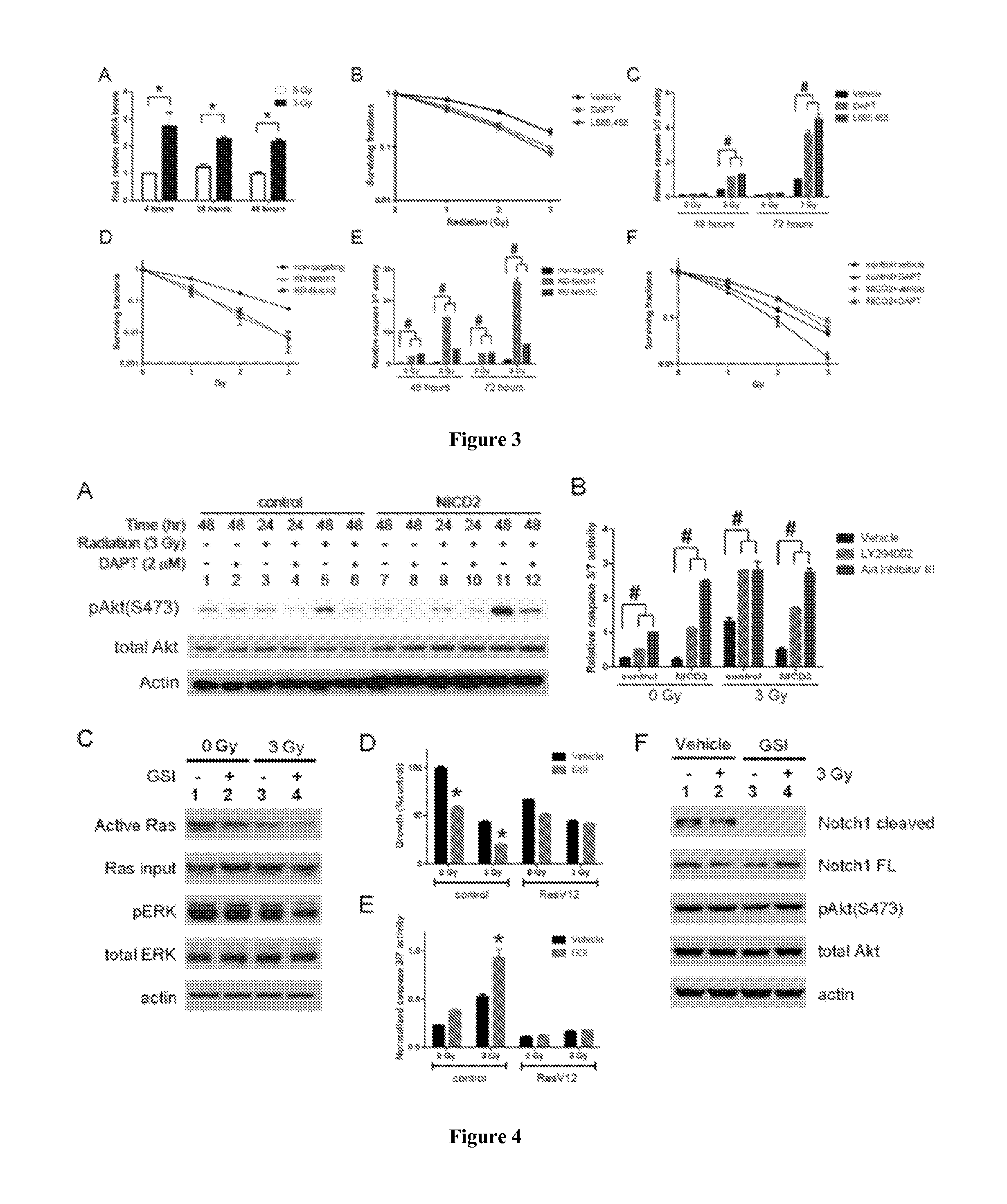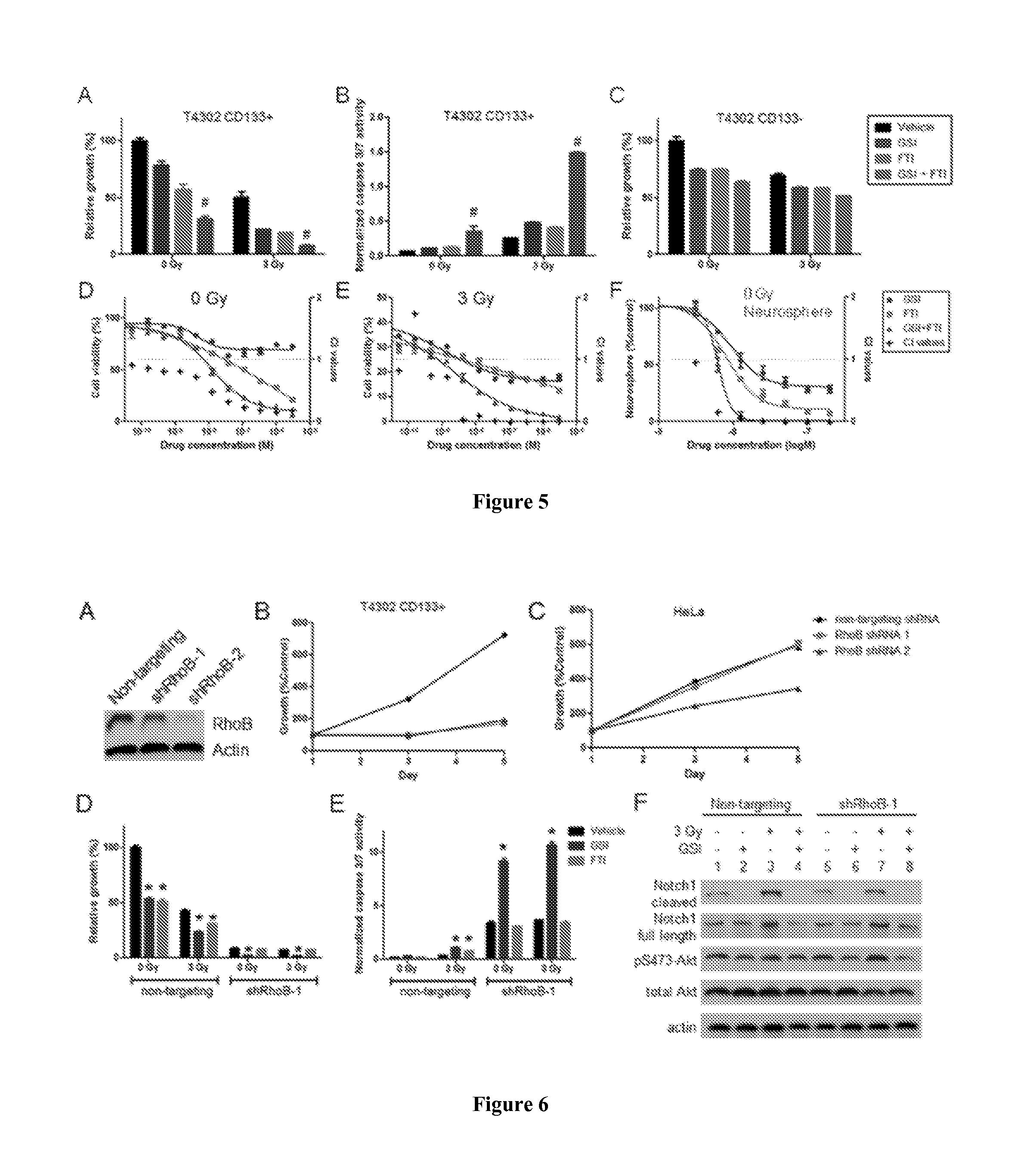Compositions and methods for targeting glioblastomas cells
a technology of glioblastoma and glioblastoma cells, applied in the field of compositions, can solve the problems of lack of mechanistic understanding of this observation, lack of known radiosensitizers that may effectively compromise the radioresistant phenotype of gscs, and large gap in knowledge regarding the signaling network responsible for radiation failure, etc., to achieve the effect of reducing symptoms and reducing symptoms
- Summary
- Abstract
- Description
- Claims
- Application Information
AI Technical Summary
Benefits of technology
Problems solved by technology
Method used
Image
Examples
example 1
[0065]It is well established that tumor resistance to radiation is due to, at least in part, the aberrant activation of pro-survival signaling networks. Glioblastoma is well documented for its rapid recurrence following radiotherapy; however, until recently, there was a lack of mechanistic understanding for this observation. Over the last few years, it has become increasingly clear that cancer stem cells (CSCs) or tumor-propagating cells (TPCs) may represent a significant driving force underlying radiation resistance and tumor recurrence in certain human tumors, including glioblastoma (1, 2).
[0066]Glioblastoma stem cells (GSCs) appear to be more resistant to radiation than matched non-stem tumor cells (3), suggesting that they are important targets to investigate the mechanistic connections between tumor radioresistance and clinical outcomes. GSCs may acquire resistance to conventional chemoradiotherapy via activation of unique signaling networks. In this regard, the present invento...
example 2
[0151]On the basis of a Notch-targeted therapy recently reported by the present inventor's laboratory and other groups, a novel combination therapy was developed and is described herein, which can include ionizing radiation, gamma-secretase inhibitors (GSIs) that block Notch signaling, and farnesyltransferase inhibitors (FTIs) that attenuate Ras and Rho GTPase activities as well as other proteins that are regulated by farnesylation. This combination treatment potently decreased growth and survival of CD133+ GBM stem cells in culture (FIGS. 8 and 9).
[0152]GBM stem cells are thought to be the primary driving force of tumor propagation and recurrence and also demonstrate stronger resistance to radiotherapy than bulk tumor cells. Therefore, effective killing of GBM stem cells may delay or even prevent tumor recurrence. Using a panel of glioblastoma xenograft samples, it was demonstrated that within a 5-day period, gamma-secretase inhibitors (RO4929097) or farnesyltransferase inhibitors ...
example 3
[0155]The present inventor has now identified a synergistic drug combination of farnesyl-transferase inhibitors (FTIs) and γ-secretase inhibitors (GSIs) that target Notch signaling. The combination of FTIs and GSIs synergistically decreased growth, survival, neurosphere formation, and radioresistance of GSCs. In contrast, GSIs and FTIs, singly or in combination, had limited impacts on non-stem GBM cells. Notably, this drug combination repressed orthotopic GBM development more effectively than either agent alone, with or without radiation. Of particular interest, a combination of RO4929097 (GSI), tipifarnib (FTI) and radiation appeared to achieve sustained control of orthotopic GBM in 2 out of 7 experimental mice. The data further suggested that Notch-dependent activation of the EGFR / Ras / Akt signaling axis played important roles in the radioresistant phenotype observed in GSCs. The synergistic interaction of GSIs and FTIs appeared to be mediated by combinatorial inhibition of Akt and...
PUM
| Property | Measurement | Unit |
|---|---|---|
| weights | aaaaa | aaaaa |
| composition | aaaaa | aaaaa |
| radiation resistance | aaaaa | aaaaa |
Abstract
Description
Claims
Application Information
 Login to View More
Login to View More - R&D
- Intellectual Property
- Life Sciences
- Materials
- Tech Scout
- Unparalleled Data Quality
- Higher Quality Content
- 60% Fewer Hallucinations
Browse by: Latest US Patents, China's latest patents, Technical Efficacy Thesaurus, Application Domain, Technology Topic, Popular Technical Reports.
© 2025 PatSnap. All rights reserved.Legal|Privacy policy|Modern Slavery Act Transparency Statement|Sitemap|About US| Contact US: help@patsnap.com



